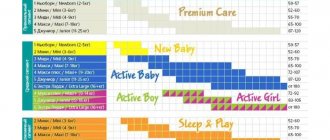Interval calculation
A simple table helps you correctly calculate the interval between contractions. To do this, mark 5 columns and several lines on a sheet of paper, preferably more than 20-30. It is better to do this electronically and print it out first, and when the spasms begin, just enter the information.
Table - How to count contractions
| Fight | Start | End | Duration | Interval |
| 1 | 12.15.30 | 12.15.47 | 17 s | |
| 2 | 12.46.10 | 12.46.18 | 18 s | 30.63 |
| 3 | 13.16.25 | 13.16.45 | 20 s | 30.70 |
| … |
The table shows approximate data for visual calculation. The pregnant woman should have an empty table in her hands, only with column designations. The numbering, the moment of the beginning of the spasm and its end do not need explanation. The duration of the contraction is calculated by simply subtracting the time difference.
To calculate the interval, use the formula for counting true contractions:
IMZH = VNTS - VKPS, where
- IMF – interval between contractions;
- VNTS – time of onset of the current spasm;
- VCPS is the time of the end of the previous contraction.
If manual calculation is difficult, it is sufficient to simply record the beginning and end of each contraction. The frequency of contractions at the start is irregular - sometimes more, sometimes less, as with training spasms. But, on average, over 2 hours, there should be a stable reduction in the interval.
For maximum relief, it is acceptable to use a contraction counting app. Various calculators are available both for download and online. The principle of their operation is no different from the manual method, only instead of a pregnant woman doing the calculations is done by a computer.
It's easy to count contractions using a program of the same name. All that is required of the woman is to press the start button when the spasm begins and the end button when it ends. The system will display a table where information about the duration of contractions and the interval between them will be correctly indicated.
How to distinguish contractions from training ones
In order not to be tormented by unnecessary suspicions, it is important for a pregnant woman to be able to distinguish training contractions from real contractions. These contractions were first described at the end of the 19th century. It was agreed that such contractions were intended specifically to prepare the woman’s body for childbirth. During the training contractions, the uterus and its cervix are prepared for labor.
There are several differences that make it possible to distinguish real contractions from training contractions or, as they are also called, false ones:
- Contractions of a training nature are irregular, with different periods of time between them.
- Such contractions do not cause pain to the woman, at most they are unpleasant sensations.
- After changing position, contractions usually go away. To do this, you just need to get up and walk around or, on the contrary, lie down.
- As a result of false contractions, the cervix does not open.
When do contractions start?
Contractions can occur at any time of the day or night, although they most often begin at night. This is due to the fact that the hormone oxytocin is most actively produced at night, and it is responsible for the onset of contractions. If a woman does not know how to determine that labor contractions have begun, it is necessary to monitor other symptoms of the onset of labor:
- if a couple of times before contractions the expectant mother’s mucous plug comes off, then most likely the contractions are already labor;
- Light leakage of amniotic fluid or violent outpouring can signal the onset of contractions;
- you need to time the contractions.
The main thing is the attitude of the pregnant woman and concentration during childbirth. If she is very worried that she will not have time to get to the maternity hospital or is afraid of complications, then she should ask the doctor to put her in storage: this gives her confidence that she will not miss the beginning of the main moment in her life and the process will be monitored first.
Counting contractions
Well, the time is approaching when, according to your calculations, it’s time to go to the maternity hospital, but before you go there, let’s count the contractions and make sure that they are not false.
Rest - 00:16
| Elapsed: 00:00:16 | in 2 hours | in 1 hour | in 30 minutes | in 20 minutes |
| Total #: 0 | 0 | 0 | 0 | 0 |
| In 10 minutes: | 0 | 0 | 0 | 0 |
| Min-Max Interval: | N/A | N/A | N/A | N/A |
| Contractions | ||||
| Start: | End: | Product: | No sx: | Interval: |
Signs of the onset of contractions
No doctor can say exactly when and at what interval a pregnant woman’s contractions begin, since this is a very individual process. Each person has their own rate of growth: quickly in 2 hours or slowly in 2 days. However, they definitely increase with a certain periodicity, and do not calm down even after a bath or No-shpa. In addition, symptoms of real contractions include:
- feeling cold or chills;
- strange dull pain in the lower abdomen and lower back;
- purgation;
- vomit;
- waste of plug or water.
At the first occurrence of contractions of the uterine muscles, you need to start noticing the frequency of their occurrence; if the period between them shortens, the continuation time increases, you should start getting ready to leave for the maternity hospital.
Although you should not rush too much, since full disclosure can take quite a long time and it is better to do this at home, when there is something to distract you. Therefore, you can leave if the interval between contractions is 10 minutes or less, and the contraction itself lasts 45 seconds. If your water breaks, you need to go immediately, because the baby will not be able to live without amniotic fluid for a long time.
Having established that the contractions are still real, it is better to give the body a rest, you can even sleep, since the woman in labor will need a lot of strength in the future, and she will not be able to sleep for a long time.
False contractions
From the 9th month of pregnancy, the expectant mother may feel short-term tension (similar to tone), as well as small contractions called training (false contractions). It is quite easy to distinguish them from the real ones:
- are unsystematic in nature;
- may be strong in the sacrum, lower back and lower abdomen;
- subside after sitting in a warm bath, taking antispasmodics or a sedative.
Most often they occur after a pregnant woman is overworked or from severe stress, but then they calm down.
How to breathe during contractions
Breathing technique during contractions is very important. If you breathe correctly, you can relieve pain and help the baby to be born sooner.
As a rule, obstetricians advise women in labor to breathe using a technique called “Candle” during labor. To do this, during the entire contraction, you need to inhale through your nose, and then exhale through your mouth. To better understand the technique, imagine that you are trying to put out a candle. Inhalations and exhalations should be quick and shallow. During this breathing process, the body experiences increased production of endorphins, which reduce pain.
Correct counting
Closer to the due date, it would be nice for a pregnant woman to get a stopwatch. This could be a regular device, a watch with a second hand, or a built-in application on your phone. It is advisable to have it on hand, as well as a pencil and a piece of paper, so that you can start counting contractions in time.
How to correctly count contractions before childbirth:
- it is necessary to record the exact start time;
- if there was no watch at hand, then it is better to wait for the next urge than to indicate approximately;
- the first spasms do not last long, it is important to remember their duration down to the millisecond;
- It is useful to write down the sensations at the moment of contraction, which helped reduce pain.
The information obtained, optimally in the form of a table of contractions, must be taken with you to the hospital. At a minimum, this will facilitate registration at the emergency department and serve as evidence of active labor.
When should you start counting contractions? When you first focus attention on an incomprehensible spasm, tone, hardening of the uterus or discomfort in the lower back. If this is a training session, it will end. In the case of true contractions, the information obtained during the count will be important for adequately determining the time of travel to the maternity hospital.
It often happens that the initial phase of spasms occurs with mild symptoms, especially in experienced pregnant women. And when a woman begins to feel contractions, this actually means that the cervix is already actively dilating. Therefore, it is the calculation of contractions and their comparison with phases that is necessary to determine the stage of labor and determine further actions.
Let's count the contractions!
Every pregnant woman, as the cherished date of birth approaches, begins to wonder - what are contractions and how to recognize them? Contractions are involuntary, regular contractions of the uterus that indicate the onset of labor.
But how can you determine that contractions are true and not false (Braxton-Hicks contractions), and that it’s really time for you to go to the hospital?! To do this, you need to count the number and duration of contractions within one hour.
But think for yourself: when you have an attack of pain, will you even bother timing the contraction?! It’s unlikely, and a stopwatch may simply not be at hand.
For this purpose, we came up with our own scrum-counter, the principle of operation of which is very simple. You only need to do two steps:
1 – press the “Oh, it hurts!” button when you feel that a contraction has begun;
2 – press the “Hurray, it’s released!” button when the contraction ends and the pain completely subsides.
Then the counter will do everything itself: it will show the start and end time of the contraction, its duration and regularity.
Oh! Hurt!
Hooray! Let go!
Delete last entry
| № | Start time | End time | Duration | The interval between contractions |
When should you go to the maternity hospital?
1. If within one hour you have from 12 to 15 contractions;
2. If contractions last from 40 seconds to 1 minute (if longer, then you are already giving birth!);
3. If contractions repeat every 4 - 5 minutes (the interval between contractions is approximately the same);
4. If contractions are regular, intense and do not go away within an hour;
5. If the contractions are strong and you are forced to breathe quickly.
It's time to get ready for the maternity hospital
In some cases, counting contractions is not worth the time. Feel free to go to the hospital if you see that:
- contractions last more than 1 minute, and the interval between them has been reduced to 8-10 minutes;
- pulling in the lower abdomen;
- lower back pain;
- bleeding appeared;
- The waters broke.
Pregnancy and the birth of a child are always exciting. With our calculator you will get rid of unnecessary stress and be ready for childbirth.
To make an appointment or get advice, call the 24-hour number or fill out the Appointment form











